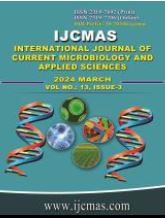


 National Academy of Agricultural Sciences (NAAS)
National Academy of Agricultural Sciences (NAAS)

|
PRINT ISSN : 2319-7692
Online ISSN : 2319-7706 Issues : 12 per year Publisher : Excellent Publishers Email : editorijcmas@gmail.com / submit@ijcmas.com Editor-in-chief: Dr.M.Prakash Index Copernicus ICV 2018: 95.39 NAAS RATING 2020: 5.38 |
Plant hormones are a group of naturally occurring, organic substances which influence physiological processes at low concentrations. There are six classical groups of plant hormones includes auxins, gibberellins, cytokinins, ethylene, abscisic acid and brassinosteroids which occur naturally. The use of plant hormones in ornamental crops is more prevalent than in edible crops. The most common types of hormones used are gibberellins, ethylene and their antagonists. Gibberellic acids are one among them which are used to enhance stem elongation of many cut flowers and to promote bud break, thus producing more flowering shoots. They are commonly used to promote flowering of long day plants and of autonomous-flowering plants of the Araceae. The largest use of plant hormones in ornamental crops is GA antagonists, which are used in pot plant production to achieve more compact and attractive structure and to promote flowering in certain woody ornamentals (Halevy, 1995) Gibberellic acids are known to coordinate and control various phases of growth and development including flowering at optimum concentrations. Exogenously applied GAs act through the alteration in the levels of natural hormone thus modifying the growth and development of flower crops.
Baurle, I., D. Caroline., 2006, The timing of developmental transitions in plants, Elsevier Inccell, 125:655-657.
Halevy. A. H., 1995, The use of plant bioregulators in ornamental crops, Acta Horticulture, 394:3.
Mithilesh, K., Singh, A. K. and Ashok, K., 2014, Effects of plant growth regulators on flowering and yield attributes of African marigold (Tagetes erecta L.), Plant Archives, 14 (1): 363-365.
Muthukumar. S., V. Ponnuswami, M. Jawaharlal and A. Rameshkumar., 2012, Effect of plant growth regulators on growth, yield and exportable quality of cut roses, The Bioscan, 733-738.
Nanda, K., Krishnamoorthy, H. N and Anuradha, T. A., 1967, Floral induction by gibberellic acid in Impatience balsamina, a qualitative short day plant, Planta, 76(4): 367-370
Rani, P and Singh, N., 2013, Impact of gibberellic acid pretreatment on growth and flowering of tuberose (Polianthes tuberosa L.) cv. Prajwal, Journal of Tropical Plant Physiology. 5: 33-42.
 |
 |
 |
 |
 |